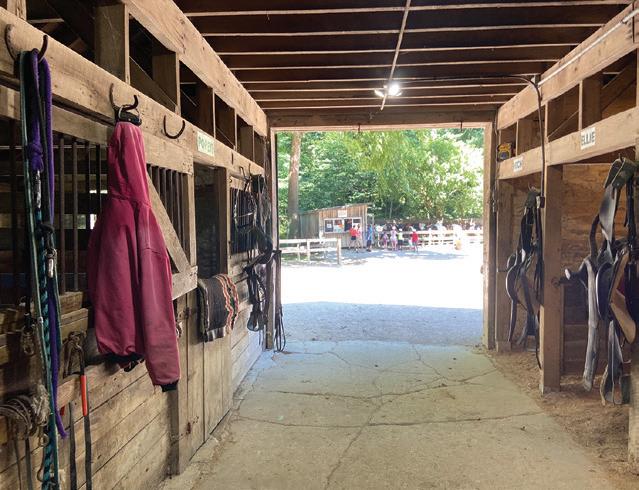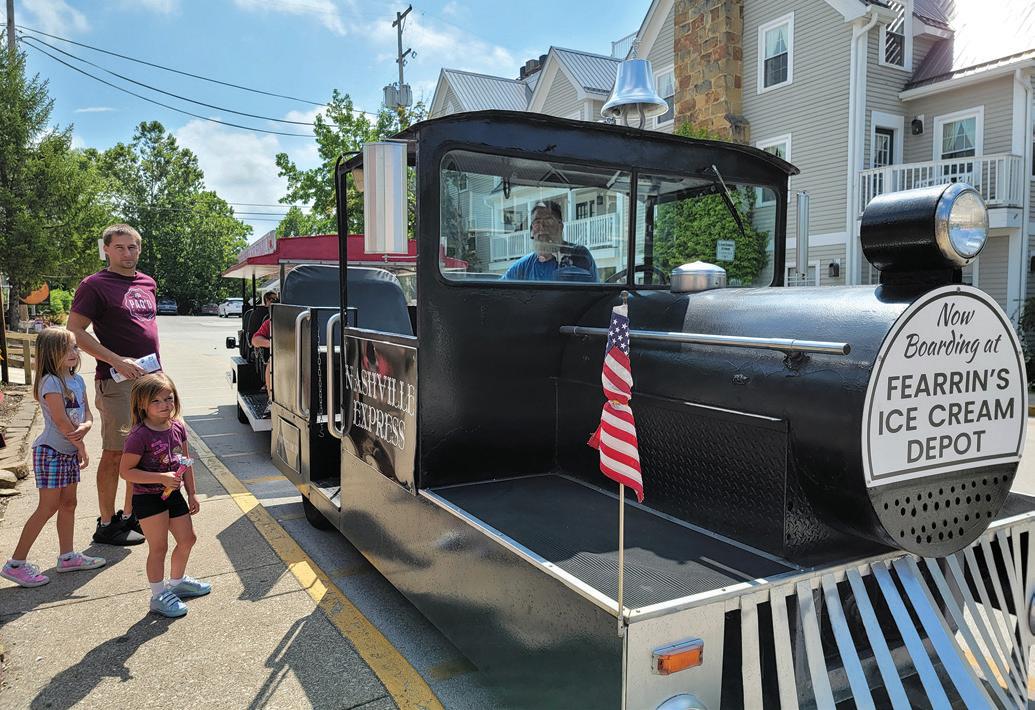
5 minute read
Brown County Saddle Barn
~story and photos by Boris Ladwig
North Vernon resident Ashdon Davis sported a tie-dyed muscle shirt, shorts, and sneakers as he rode his brown horse the last few yards back to the Saddle Barn at Brown County State Park. His sunglasses shielded him against the bright rays of the mid-summer’s early evening sun.
Davis, who drives a 28-foot flatbed truck for a living, had come to the barn for the first time and said he really enjoyed his 35-minute trail ride, which he completed with family and friends.
“It was awesome,” he said.
Thomas Slick, of Seymour, who had ridden in the same group as Davis, said he, too, had a good time.
Slick, a home construction worker, had rented a cabin in the park the night before to attend a large family gathering. Someone told him about the horse barn, and he thought his sons, Jaylex, 10, and Jairston, 12, would enjoy it.
“It was really relaxing,” Jairston said.
Slick said he had not been on a horse since he was a child in Tennessee and said the family enjoyed the park’s tranquility and the animals they spotted.
“Nice to do something that’s … outdoors,” he said.
Spending time outdoors in Brown County’s beautiful environment brings some people back to the barn year after year, said Jordan Bair, who has worked at the facility for nearly a quarter century, the last 15 years as operator.
Seeing parents and children enjoy the flora and fauna—rather than spending time glued to the TV, gaming console or cell phone—make the work worthwhile, he said.
Visitors never know what animals they might encounter, but they frequently see deer, turkeys, or even coyotes. Some of the city slickers who visit the barn have trouble identifying those animals—and even horses.
“Some city kids who come and see black and white horses call them cows,” Bair said.
He runs the facility through a contract with the state, which gives him 26 acres of the park. Rides start at 9 a.m., with the last rides leaving at 4:30 p.m. Trail rides cost $21 for 35 minutes on a 2.2-mile loop, and $31 for 3.3-mile, one-hour loop, with a $1 discount for those who pay cash.
Children under 17 must wear a helmet. All guests are accompanied by a guide. Smaller children can take parentassisted pony rides around an oval near the barn for $3.50 per lap.
The barn offers rides from the second week in March to the second week in November. Bair said as many as 250 people can show up per day. October is busiest, primarily because of the fall foliage.
Bair recommends that people come in spring, because of the more pleasant temperatures and smaller crowds.
“You can watch everything come to life,” he said.
Bair’s day typically starts at 8 a.m., when he saddles up the 60 horses and puts out hay for them. They eat about 600 bales per year.
The horses are mostly very docile quarter horses, he said. A booth near the barn displays some of their names: Betty, Peaches, Zoey, Daisy. One of the horses for kids is named Nugget, but Bair said everyone calls it Chicken Nugget.
The barn dates back almost a century and was built by the Civilian Conservation Corps established by President Franklin D. Roosevelt. A plaque at the barn reads that the president created the corps following the 1929 stock market crash, which left about 18 million people unemployed, of whom about 2 million became homeless.
“The CCC provided employment, income and job training to unemployed men, aged 18 to 23,” the plaque reads. “They were paid $30 monthly, $25 of which was sent directly to their needy families.”
The plaque states that almost 64,000 Hoosiers were assigned to CCC camps in the state and that the workers were “instrumental in furthering Indiana’s fledgling state parks, reservoirs and forests. At the time, many properties were without basic infrastructure. Much of the land that became state property was severely eroded and treeless. The CCC built erosion controls, planted trees, and built roads and water systems.”


Bair saddles up the 60 quarter horses every morning and puts out hay for them.
Bair said the barn’s economics can be challenging because four months out of the year, the horses don’t generate revenue, but still have to be cared for.
He usually breaks in new horses during that period. He often buys them at auctions. Good, gentle horses can cost $5,000 to $8,000.
“Buying a horse is about like buying a car,” he said. “Nobody wants an ugly one.”
Bair said dealing with the horses is less challenging than dealing with customers who think they know what they’re doing but don’t.
“The animals are the easy part,” he said. “You just have to learn to read them.”
For his most recent contract with the state, Bair agreed to be paid a flat fee. That worked out well last year during the pandemic, as many people sought outdoor escapes from being cooped up indoors. Last year’s traffic was comparable to before the pandemic, Bair said, but this year, he has seen fewer customers. He suspected higher gas prices are playing a role.
Like many businesses, the barn is struggling to hire. Bair said that as more people grow up in towns, fewer know how to deal with horses.
Finding good horses, too, has become more difficult over the years, he said.
Bair said he has lots of repeat customers, including a family from Kentucky that comes twice a year including every October. He has seen the children grow up. The family sends him Christmas cards.
“You meet a lot of nice people,” he said. “The good days definitely outweigh the bad days.”
You can get more information about the barn at <browncounty-saddlebarn.com> or by calling 812-988-8166.








